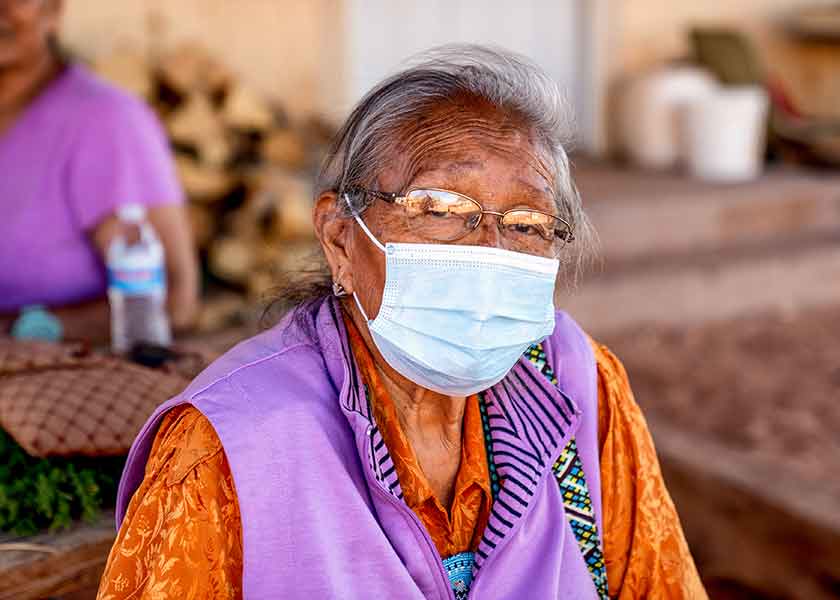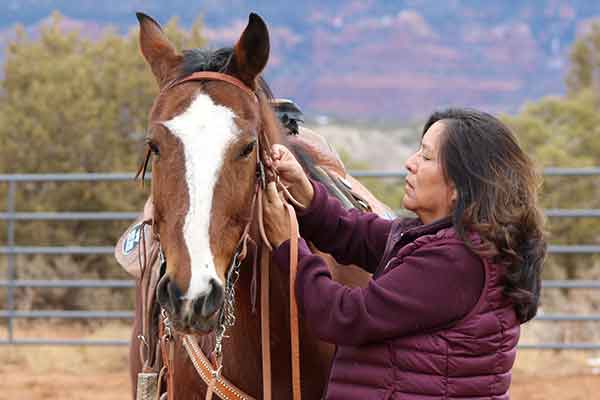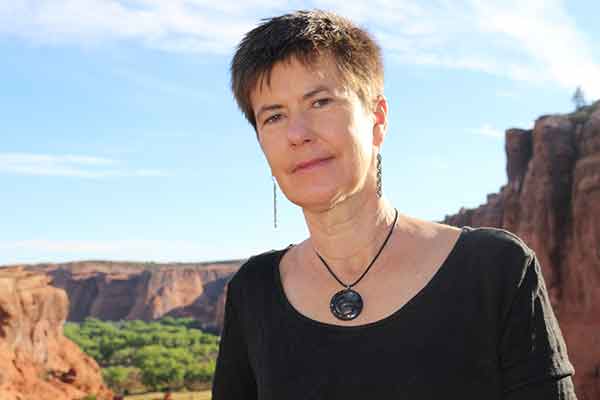
As a high school student who excelled in science and health, Annie Moon, MSN’03, wanted a career that would both challenge her and give her the opportunity every day to make a difference in people’s lives.
Nursing fit the bill, and she has worked her entire career on the Navajo reservation where she grew up, first as a registered nurse, then as a leader and manager after earning her master of science in nursing.
Now a pediatric nurse practitioner, Moon supervises the Department of School and Health Services at the Indian Health Services’ Chinle Service Unit in Arizona, overseeing the delivery of clinical services to underserved Native American adolescents in five high schools and three middle schools. One of her colleagues and friends is fellow Vanderbilt alumna Dr. Jill Moses, MD’91, public health director of the Chinle Service Unit.
Even before the pandemic, their days were challenging and full. But when COVID-19 struck the Navajo Nation in the spring of 2020, Moon says, “Everything changed.”
The coronavirus hammered the area, which already was contending with widespread poverty and poor health conditions. During the spring surge in 2020, the Nation’s infection rate per capita was the highest in the country, exceeding that of even hard-hit New York and New Jersey.
The Navajo Nation fought back with strict lockdowns and mask mandates. By summer’s end, the curve was flattening. But during the fall, pandemic fatigue grew across the country and COVID numbers began to rise.
The Navajo Nation was no exception. By mid-November, the case count rose above the May peak. Full-on lockdowns plus special weekend curfews were issued, while visitors and tourists were banned and only essential businesses were allowed to open, albeit with shortened hours. Despite these efforts, the upsurge in case numbers continued, and the health care system strained under the demand.
“We are really in the thick of it again,” says Moon, as 2020 draws to a close. “We were doing so well over the summer with new case numbers in the single digits. People relaxed a little and family gatherings started happening. Then it started all over again.”
With schools going virtual, Moon’s in-school clinics became phone visits, and her focus switched to fighting the pandemic. Now her long days start and end with virtual meetings of the public health response team.
 “We talk about cases and clusters and what we are seeing,” she says. “Because we went through this in April and May, we are more prepared this time. We know what to expect and how to do certain things.
“We talk about cases and clusters and what we are seeing,” she says. “Because we went through this in April and May, we are more prepared this time. We know what to expect and how to do certain things.
But,” she adds, “I hate to think about what the next few months will be like.”
Challenges for the Nation
The Navajo Nation, established by treaty in 1868, is the largest Native American reservation in the United States. While wholly part of the U.S., the Nation has its own government and is home to more than 250,000 people. Its borders encompass 27,000 square miles—somewhere between the size of South Carolina and West Virginia—much of it in the high desert regions of Arizona, New Mexico and Utah.
Despite having a relatively low population density, the Navajo Nation has faced a unique set of challenges in slowing coronavirus. Underlying health conditions, a lack of infrastructure, poverty, a health care system stretched beyond its limits, and certain cultural practices that are common among the Navajo all have been factors in its spread.
The health of Native Americans ranks lower than the nation’s overall. According to the Indian Health Service, diabetes is 300 percent more likely in American Indians and Alaska natives than the general U.S. population. That, paired with high rates of prediabetes, obesity, heart disease, high blood pressure, substance use disorder and depression, presents a significant health care challenge in the time of COVID.
Adding to these pressures are the infrastructure issues that plague the region. About 15,000 of the 55,000 homes on the reservation do not have electricity (making up 75 percent of all unelectrified households in the U.S.). The Navajo Nation Department of Water Resources estimates that about 30 percent of the population does not have access to clean, reliable drinking water. One in three Navajo citizens do not have indoor plumbing. Of the more than 14,000 miles of roads crossing the Nation, less than a quarter is paved. The remainder? Gravel or dirt.
In addition, food insecurity affects more than 75 percent of households in the Navajo Nation. With only a dozen or so grocery stores on the reservation, many have no choice other than the unhealthy fare available at convenience stores and trading posts.
“A significant percentage of our households are extremely impoverished,” Moses says.
Altogether nearly 40 percent of the Navajo Nation live in poverty, and the unemployment rate is at least three times the national average. But even those who have jobs find themselves in a difficult predicament. They go to work, virus or not.
“Despite the pandemic,” Moses says, “they can’t afford not to work, and they don’t have access to telework.”
And to complicate matters further, Navajo often live in small family clusters of several homes. The close-knit nature of the culture, which would normally be a strength under different circumstances, actually makes the Nation more vulnerable to the disease’s spread.
“The families are interdependent,” Moses explains. “The younger generation gathers wood and cares for the elders. One house may have running water that all the family members use. They may share a refrigerator or kitchen. Family is everything here, but these crowded households are not good when you are trying to control the spread of COVID.”
From Vanderbilt to public health
 Jill Moses was first introduced to public health during her time at Vanderbilt University Medical School, when she did a rotation on the reservation.
Jill Moses was first introduced to public health during her time at Vanderbilt University Medical School, when she did a rotation on the reservation.
Moses still appreciates her mentors on the Vanderbilt faculty, including Dr. Kathy Edwards, the Sarah H. Sell and Cornelius Vanderbilt Professor of Pediatrics; Dr. William Schaffner, professor of health policy and professor of medicine; Dr. Marie Griffin, professor of health policy, emerita; and Dr. Lewis Lefkowitz, professor of preventive medicine, emeritus.
Moses went on to residencies in pediatrics and preventive medicine at Johns Hopkins University, where she also earned a master’s in public health in 1995.
“At Hopkins, a couple of my mentors were giants in the field of public health and they both had their start in the Indian Health Service,” Moses says.
She returned to the Nation in 1996 and now is director of the Chinle Service Unit, which is part of the Navajo Area Indian Health Service, an agency within the Department of Health and Human Services. The IHS is the principal federal health care provider and health advocate for American Indians and Alaska Natives; its goal is to raise their health status to the highest possible level.
Within the Navajo Nation, Moses and the IHS work with agencies on the federal, state and tribal levels, as well as nonprofits and community organizations, to coordinate health care delivery for the Navajo. She finds that practicing within a public health system is perfect for her.
“I can practice in the best possible way,” she says. “Issues such as ‘Can my patient afford this medicine?’ don’t exist. I’m working in a system that can put the priority not on the bottom line but on improving the health of the population. To me, it’s the best way to provide health care.”
Under her leadership, the office has increased its staff from 14 to more than 80 and established programs in immunizations, injury prevention, nutrition, health promotion, disease prevention, and school-based clinics. She also still sees pediatric patients at the Chinle clinic.
Friends and colleagues
 Moses and Moon have been colleagues and friends for more than 20 years. They met when Moon was a pediatric nurse at a satellite clinic.
Moses and Moon have been colleagues and friends for more than 20 years. They met when Moon was a pediatric nurse at a satellite clinic.
“She became our first pediatric case manager,” Moses says of Moon. “We worked together, our kids were the same ages—we’ve gone through a lot together.”
When Moon talked about wanting to get her master of science in nursing, it was Moses who suggested Vanderbilt School of Nursing. Moon packed up her two sons and moved to Nashville for the intensive year of study.
“Looking back, I can’t believe I did that,” Moon says. “I was a single mom, and people normally don’t go off the reservation and do things like that.”
She recalls that Moses’ mother, Linda, took her under her wing. “She would have us over for dinner, and she would pick up the boys from school when I was busy at Vanderbilt,” Moon says. “I never would have finished without the Moses’ support. I can’t say enough good things about them.” (Jill’s father, Dr. Hal Moses, MD’62, professor of cancer biology, emeritus, founded and served as director of Vanderbilt-Ingram Cancer Center.)
After earning a master of public health and a public health training certificate in American Indian health from Johns Hopkins in 2015, Moon launched Yéigo! (Navajo for “with spirit”), a scalable initiative to promote healthy lifestyles among tweens and teenagers aimed at breaking the cycle of obesity and diabetes. She also led the Chinle Service Unit’s HPV vaccination campaign in 2018. The Nation’s 82.7 percent vaccination rate was among the highest in the country.
Under Moon’s leadership, the school clinic network in the Navajo Nation has grown in number of schools served and quality of care provided while adding new services, including mental health support. She is also trained as a sexual assault nurse examiner to help victims of sexual violence.
Moses, who expanded Chinle’s Office of Native Medicine, celebrates Moon’s work while also acknowledging key support from native healers. The HPV vaccine, which protects against the sexually transmitted human papillomavirus, was a hard sell for area parents.
“We worked with native healers to develop some messaging that was culturally sensitive,” Moses says. “Girls here go through a puberty ceremony, so we developed materials that tied getting the vaccine to this important declaration of adulthood.”
Moon, fluent in Navajo, is one of the only Natives serving on the medical staff at Chinle Hospital. She also looks for ways to integrate modern medicine with the Navajo traditional way of life.
Both women have been recognized for their efforts. Moon was the inaugural winner of the Vanderbilt University School of Nursing’s Alma Gault Alumni Award for Public Service in 2018. She also received the Navajo Area Director’s Award for Outstanding Healthcare Provider. Moses was awarded the Distinguished Achievement Award in 2011 from her undergraduate alma mater, Carleton College.
The duo also were recognized together in 2018 by the Association of American Cancer Institutes, in partnership with the Centers for Disease Control and Prevention and the American Cancer Society, for the HPV vaccine campaign.
Fighting COVID…again
Since the pandemic has reemerged, Moses has focused on scaling up the Chinle Service Unit’s response.
“We’ve been in a state of emergency since spring. Our numbers were really low in August and September,” Moses says. “We were reopening, restrictions were being eased across the reservation. But the region around us started to get worse. A lot of people work off the reservation and do a lot of shopping off the reservation. Things just exploded again when the weather turned.
“The reservation is not an island,” she adds, “but it might be easier if we were.”
Her days are now dominated by the virus, as she coordinates education and disease control measures with vaccination plans.
“We have a lot of competing priorities we will have to juggle,” Moses says. “We’ve done most of our flu vaccination, and we are well into prepping our vaccination plans. We’re working on how we will provide health care during the pandemic—ER visits, hospitalizations. We were short on nurses before COVID started, and now we’re competing with health systems across the country.
“It is challenging to contemplate what the next few months will bring.”
For her part, Moon leans on the skills she learned at Vanderbilt during this protracted fight against COVID-19. “My MSN program still helps me so much,” she says. “Learning how to prepare, how to manage people and patients—along with the science, those are the things I keep with me.”
The pandemic has impacted Moon on a very personal level. Even though she lives just 200 yards from her parents, her visits have been few—and masked. But she hasn’t lost hope.
“Navajos have been through a lot: historical trauma, wars, the Long Walk [when they were forcibly relocated by the U.S. government in the 1860s], diseases. We’ve always managed to survive,” she says. “We are resilient. I’m just focused on getting through this wave, people getting the vaccines and moving forward.”
by Jan Read
Jan Read is a freelance writer based in Nashville.
Images, from top:
A Navajo elder wears a face mask to protect against COVID-19. Photo: grandriver, E+, via Getty Images
Annie Moon puts the bridle on her bay mare, August Moon. The School of Nursing alumna says there’s something about being around horses that seems to naturally relieve stress. Photo: Ryan Goldtooth
Jill Moses in scenic New Mexico where she lives and works. Moses first came to the Navajo Nation to do a rotation as a Vanderbilt School of Medicine student. Photo: Ryan Goldtooth
From left, Moon and Moses continue fighting COVID among the Navajo into the winter months. Photo: Ryan Goldtooth